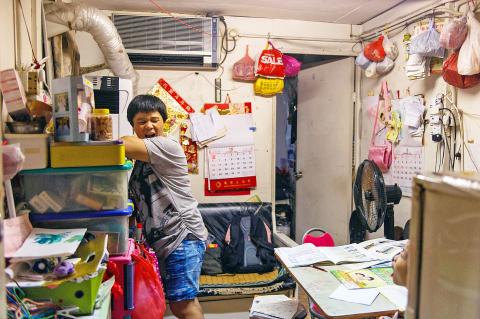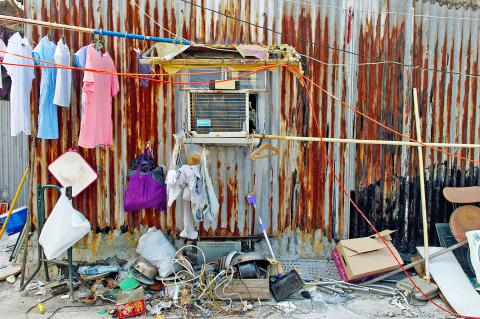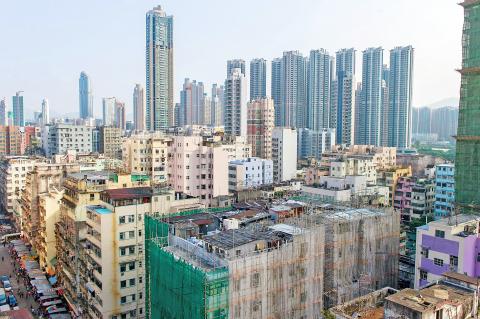Their precarious rooftop houses have offered refuge from an unaffordable Hong Kong property market, but some of the territory’s poorest residents face losing their makeshift homes as the government seeks to dismantle them.
Perched on top of older buildings, the ramshackle dwellings may offer penthouse views in a city where space is at a premium, but the flimsy structures are frequently battered by typhoons and magnify oppressive summer heat.
The government says they are too unsafe, and many of those who live in them agree.

Photo: AFP
照片:法新社
With luxury apartments selling for more than US$50 million and a waiting list for public housing stretching for years, however, they say there is nowhere else for them to go.
“The rent is so high out there, how can we leave here? It costs at least several thousand (Hong Kong) dollars, we cannot afford it,” said Su Xingyun, whose family of four lives in a tiny two-room rooftop hut which is under a government removal order.
Their chipboard and corrugated iron home is one among a dark warren of around 10 shacks on top of a 10-storey building in the working-class Sham Shui Po District.

Photo: AFP
照片:法新社
Su, 46, moved from mainland China to join her husband, who had lived on the rooftop for 20 years, but would like a better home for her young daughters.
She says she has been applying for public housing for several years.
“During a typhoon I’m really afraid. I’m worried that the roof will collapse because I can feel the walls shaking. It’s not safe for a family.”

Photo: AFP
照片:法新社
“We don’t have any privacy,” added Su. A dank shared kitchen with a toilet and shower hose in one corner is where the family cook and wash.
Rooftop residents either own their homes or pay minimal rent to shady landlords. Upgrading to private accommodation can prove impossible, campaigners say.
“The deposit, commission and first month’s rent for even a tiny sub-divided flat can be more than HK$10,000 (US$1,300),” said community worker Angela Lui of local campaign group the Society for Community Organization (SoCO). “It’s a big number and families can’t afford it,” she says.
Many rooftop homes were built in the 1950s, when there was an influx of immigrants from China and few building restrictions. Now, it is an even mix of migrants and Hong Kongers who live there, says Lui. Some have done so for more than 30 years.
While there is no exact record of the number of rooftop residents, there are more than 170,000 substandard homes throughout the city, according to the authorities.
The government says its campaign against “unauthorized building works” (UBWs), which include rooftop homes, is in the interests of public safety. Between 2001 and 2011 the buildings department removed 400,000 UBWs.
The pace of rooftop removals is now outstripping the ability to rehouse, says Lui, with a lack of coordination between the buildings and housing departments.
Landlords and tenants of UBWs are not entitled to compensation from the government.
“No one told me this was illegal,” said Su’s neighbour Quang Xuan, 55, a refugee from Vietnam who works as a handyman and has lived in his rooftop home for 10 years.
“When people told me we had to move out I said to myself OK, I will go if I can find another place. But if I can’t find somewhere I can afford, I risk becoming homeless, living under a flyover or in a park.”
SoCO estimates that there are about 1,200 homeless people in Hong Kong.
Both the buildings and housing departments declined interview requests but said in statements that they worked closely together and that public rental housing would be offered to those who were eligible.
Eligibility criteria include means testing and living in the rooftop home for more than two years prior to the removal order.
The buildings department said it would not, by law, make any resident homeless.
(AFP)
在普遍難以承受的香港昂貴房市下,搖搖欲墜的天台屋,已然成為貧困居民的避風港,不過因政府要拆除供其棲身的臨時屋,居於香江的一些赤貧居民將面臨無房可住的窘境。
這些棲身在舊大樓頂樓加蓋且隨時可能倒塌的房屋,雖有著在城內高價才能買到的高樓層豪華公寓的景觀,但其脆弱的搭建結構,經常被颱風侵襲,炎炎夏日則是悶熱難耐。
政府表示這些建築物太不安全,而住在天台屋裡的居民也頗有同感。
然而,面臨動輒要價超過五千萬美元的豪華公寓,以及要排隊等待多年後才能入住的公共房屋(公屋),天台屋居民表示他們實在無處可去。
一家四口居住在一處空間狹小並被政府勒令拆除的天台屋的蘇星雲(譯音)表示:「外頭租金那麼貴,我們該如何住得起?要價至少也要港幣成千上萬元,我們負擔不起。」
位於勞工階級居住的深水?街坊,這間由硬紙板與波浪狀鐵皮搭建的家,是夾雜在十層樓大樓頂樓上擠滿十間陰暗棚屋中的一間。
現年四十六歲的蘇星雲,從中國搬遷過來與其已在屋頂住了二十年的丈夫同住,即便如此,她還是希望能給予其年幼女兒們一個更好的居所。
她說她多年來已提出公屋的申請。
她表示:「颱風來襲時,我非常害怕。因我能感覺到牆壁在震動,很擔心屋頂會倒塌。這對一個家庭而言,並不安全。」
她補充道:「我們沒有任何隱私。」一個潮濕的共用廚房,而廁所與淋浴就在其中一角,這就是這家人煮飯與盥洗的地方。
天台屋居民不是買的就是向遊走法律邊緣的房東以低廉租金租的。伸張居住正義的倡議人士們表示,將這些房子變造提升為私有住宅,證實是不可能的。
當地一個名為香港社區組織協會的倡議團體的一名工作人員安潔拉‧呂表示:「租一個狹小分租公寓,包括押金、佣金與第一個月的租金就要超過港幣一萬元(一千三百美元)。」她說:「這是個大數目,許多家庭負擔不起。」
呂表示,許多天台屋建於正值大量中國移民潮與缺乏對大樓立法管制的五0年代。現在天台屋裡有混雜著移民者與香港本地人居住。有些人甚至一住就住了超過三十年。
因政府並未為居住在天台屋的居民進行登記,所以不知道有多少人;但據官方數據,整個城市裡有超過十七萬戶不合格建築。
港府表示其是為了公共安全,才施行拆除包括天台屋的「違例建築物」的政策。在二00一年與二0一一年間屋宇署已拆除四十萬座「違例建築物」。
然而,呂表示拆遷速度現已超過建屋速度,缺乏香港房屋委員會及房屋署與屋宇署間的配套。
「違例建築物」的房東與租客並不符合政府補助的資格。
蘇的五十五歲來自越南的鄰居Quang Xuan表示:「沒人告訴我這是違法的。」以打雜維生的Xuan已居住在天台屋達十年。
「當有人告訴我,我們必須搬離,我就告訴自己沒問題,若能找到另一個棲身之所,我將會搬離。但我若是找不到一處可以負擔得起的房子,我將冒著成為無家可歸、夜宿天橋下或公園的風險。」
香港社區組織協會估計,香港大約有一千兩百位無家可歸的住民。
香港房屋委員會及房屋署與屋宇署皆不願接受訪問,僅以聲明表示,他們有互相配套,而公屋會開放給符合入住資格的居民承租。
公屋資格包括能在拆除令之前,提出已住在天台屋兩年以上的證明。
香港房屋委員會及房屋署表示,他們依法不會讓任何居民無家可歸。
(法新社/翻譯:林亞蒂)

When people listen to music today, they typically use streaming services like YouTube or Spotify. However, traditional formats like vinyl records have regained popularity in recent times. Vinyl records are circular discs that store music in grooves on their surfaces and are played on a turntable. As the turntable’s needle runs along these grooves, it picks up vibrations and translates them into sound. The history of vinyl records dates back to the late 1800s, but material and technological challenges delayed mass production until the 1950s. Despite early versions having short playtimes and poor sound quality, vinyl records introduced a new era

A: Brazilian jiu-jitsu, known as “BJJ,” has become more and more popular. Even Hollywood stars like Halle Berry and Tom Hardy are obsessed with it. B: Some Asian stars, such as Taiwanese actor Eddie Peng and South Korean actor Lee Joon-gi, have also practiced this martial art. A: BJJ is not just a martial art, but also a combat sport. B: I’ve always wanted to try it, but I’m worried about getting injured. A: Diana Wang, a US doctor of physical therapy, is holding a BJJ seminar at PMA Brazilian Jiu-jitsu in Taipei Friday night. Let’s go check out how we

Picture a 45-foot-long animal with a 5-foot-long skull and 3-foot-long arms. It may not seem strange until you realize that a human with those proportions would be 6 feet tall with 5-inch arms. Although the Tyrannosaurus rex went extinct 65 million years ago, the mystery of its unusual body __1__ has fascinated scientists for over a century. Barnum Brown, the paleontologist who first discovered T. rex fossils, initially found it hard to believe that the tiny arms belonged to such a __2__ creature. One of his colleagues speculated that the short forelimbs might have been used to hold the

A: Actually, Brazilian jiu-jitsu is particularly good for small people like you. B: Really? How so? A: According to Diana Wang, a US doctor of physical therapy, the BJJ’s purpose is to help smaller, weaker people defend themselves by using various techniques, such as leverage. B: That sounds interesting. What time does Dr Wang’s BJJ seminar begin tonight? A: The event is scheduled for 7:30pm at PMA Brazilian Jiu-jitsu in Taipei. Admission is free, but donations are welcome. A: 其實你的個子比較小,很適合練巴西柔術呢。 B: 真的嗎?為什麼? A: 據美國理療醫師王幼瑞博士說,巴西柔術的概念是讓弱小的人,也能利用槓桿作用等技巧防身。 B: 真有趣,王醫師的巴柔研討會幾點開始? A: 今晚7點半在「台北巴柔運動館」,免費入場自由樂捐唷! (By Eddy Chang, Taipei Times/台北時報張迪)